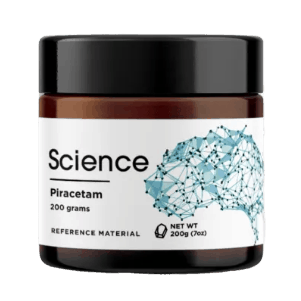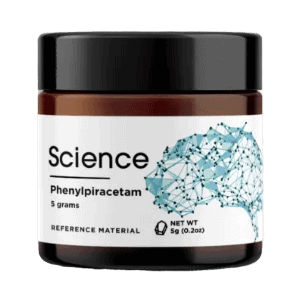
Phenylpiracetam and piracetam are two popular nootropics that have gained attention for their potential cognitive-enhancing effects.
While both belong to the racetam family, they have distinct differences in terms of potency, mechanisms of action, and user experiences.
This article delves into the key features, benefits, drawbacks, and comparative aspects of phenylpiracetam and piracetam, providing a comprehensive guide for those seeking to optimize their cognitive performance.
Table of Contents
What Are the Key Features of Piracetam and Phenylpiracetam?
Piracetam, the original racetam, is known for its mild cognitive-enhancing effects, while Phenylpiracetam, a newer derivative, is considered more potent.
Piracetam has a longer history of use and research, whereas Phenylpiracetam is gaining popularity for its stronger effects on focus, energy, and motivation.
What Is Piracetam and What Are Its Ingredients?

Piracetam (C6H10N2O2) is a synthetic nootropic compound derived from the neurotransmitter GABA. Piracetam’s chemical structure is 2-oxo-1-pyrrolidine acetamide, and it’s composed of a 2-pyrrolidinone base with an acetamide group attached.
It’s considered the prototype of the racetam family, which includes other cognitive enhancers like aniracetam, oxiracetam, and pramiracetam.
What Is Phenylpiracetam and What Are Its Ingredients?

Phenylpiracetam (C12H14N2O2), also known as phenotropil or carphedon, is a more potent derivative of piracetam. It’s structurally similar to piracetam but includes an additional phenyl group attached to the pyrrolidine ring.
This modification enhances its bioavailability and blood-brain barrier permeability, resulting in greater potency compared to piracetam.
How Do the Ingredients in Piracetam and Phenylpiracetam Compare?
The main difference between piracetam and phenylpiracetam lies in the presence of the phenyl group in phenylpiracetam. This structural variation contributes to phenylpiracetam’s increased potency, typically requiring lower doses to achieve similar or enhanced effects compared to piracetam.
While both compounds share the pyrrolidine ring structure, the phenyl group in phenylpiracetam alters its pharmacokinetic properties and interactions with neurotransmitter systems.
Piracetam vs Phenylpiracetam Dosage
Piracetam is typically taken in higher doses, ranging from 1,200-4,800 mg per day, divided into 2-3 doses. Phenylpiracetam, being more potent, requires lower doses of 100-200 mg taken 1-2 times daily.
| Nootropic | Typical Daily Dosage |
|---|---|
| Piracetam | 1,200-4,800 mg |
| Phenylpiracetam | 100-200 mg |
How Do Piracetam and Phenylpiracetam Work for Cognitive Enhancement?
Piracetam and Phenylpiracetam share similar mechanisms of action, influencing acetylcholine and glutamate neurotransmitter systems in the brain. They enhance neuronal communication, plasticity, and neuroprotection.
However, Phenylpiracetam also exhibits stimulant-like effects due to its influence on dopamine and norepinephrine transmission. It has also been found to be 30-60 times more potent than piracetam in terms of its cognitive-enhancing effects, according to a study by Zvejniece et al. (2020).(1)
What Are the Cognitive Benefits of Using Piracetam?
Piracetam has been studied for its potential cognitive benefits, including:
- Improved memory and learning
- Enhanced verbal fluency and communication skills
- Increased mental clarity and focus
- Reduced mental fatigue and improved mental stamina
- Neuroprotective properties and potential prevention of age-related cognitive decline
What Are the Cognitive Benefits of Using Phenylpiracetam?
Phenylpiracetam shares many of the cognitive benefits associated with piracetam, but its enhanced potency may result in more pronounced effects, such as:
- Significant improvements in memory, learning, and information processing
- Heightened focus, concentration, and attentional capacity
- Increased mental energy, motivation, and reduced fatigue
- Enhanced creative thinking and problem-solving abilities
- Potential anxiolytic and mood-enhancing properties
How Do Piracetam and Phenylpiracetam Differ in Their Mechanisms of Action?
While the exact mechanisms of action for piracetam and phenylpiracetam are not fully understood, they are believed to modulate various neurotransmitter systems and improve neuronal communication.
Piracetam has been shown to enhance cholinergic and glutamatergic neurotransmission, while phenylpiracetam additionally modulates dopaminergic and noradrenergic systems.
Phenylpiracetam’s increased potency may be attributed to its greater affinity for these neurotransmitter receptors and its ability to cross the blood-brain barrier more efficiently.
What Are the Pros and Cons of Piracetam and Phenylpiracetam?
Piracetam offers several benefits, including improved memory, enhanced learning ability, and increased mental clarity. It’s well-tolerated and has a long history of use, with few reported side effects. However, its effects can be subtle, and higher doses may be required to achieve noticeable cognitive enhancement.
Phenylpiracetam provides similar cognitive benefits but with greater intensity and faster onset. Many users report increased focus, motivation, and physical endurance. The drawbacks include a shorter duration of effects and a higher potential for side effects like anxiety and overstimulation.
What Are the Advantages and Limitations of Piracetam?
Advantages of piracetam include:
- Well-researched and established safety profile
- Minimal side effects at recommended doses
- Suitable for long-term use
- Affordable and widely available
Limitations of piracetam are:
- Requires higher doses compared to phenylpiracetam for similar effects
- May take several weeks of consistent use to notice significant cognitive improvements
- Not approved by the FDA
What Are the Advantages and Limitations of Phenylpiracetam?
Advantages of phenylpiracetam include:
- Higher potency and faster-acting compared to piracetam
- Lower doses required for cognitive enhancement
- Potential additional benefits such as increased physical stamina and reduced anxiety
Limitations of phenylpiracetam are:
- Less research is available compared to piracetam
- Higher risk of side effects, especially at higher doses or with prolonged use
- May develop tolerance more quickly, requiring cycling or breaks
- Not approved by the FDA
How Do Users Experience Piracetam and Phenylpiracetam?
Users typically report that phenylpiracetam provides stronger cognitive-enhancing effects compared to piracetam. At lower doses, phenylpiracetam can increase focus, mental energy, and motivation, while higher doses may also improve creativity and verbal fluency.
What Are Common User Experiences and Testimonials for Piracetam?
Many piracetam users report positive experiences, describing improvements in memory, focus, and mental clarity. Some students and professionals use it to enhance learning, productivity, and problem-solving abilities.
Others find it helpful for managing age-related cognitive decline or supporting recovery from brain injuries.
One user shared, “Piracetam has been a game-changer for my studies. I can retain information better and think more clearly during exams.“
Another noted, “As someone in their 60s, I’ve noticed a significant improvement in my memory and mental sharpness since starting piracetam.“
What Are Common User Experiences and Testimonials for Phenylpiracetam?
Phenylpiracetam users often report more pronounced cognitive effects compared to piracetam. Many describe increased motivation, laser-like focus, and enhanced mental and physical energy.
Some find it particularly useful for demanding cognitive tasks or high-pressure situations.
An entrepreneur shared, “Phenylpiracetam gives me the drive and mental clarity to power through my workday and tackle complex projects with ease.“
A student mentioned, “During exam season, phenylpiracetam helps me stay focused and productive for hours on end. It’s been a lifesaver.“
How Do Individual Responses to Piracetam and Phenylpiracetam Vary?
Individual responses to piracetam and phenylpiracetam can vary significantly due to factors such as genetics, brain chemistry, age, lifestyle, and pre-existing cognitive function. Some users may experience pronounced benefits, while others may notice subtle or no effects.
Optimal dosage and frequency of use may also differ between individuals, and it’s crucial to start with lower doses and assess personal tolerance and response before increasing intake.
What Are the Side Effects and Safety Profiles of Piracetam and Phenylpiracetam?
Piracetam is generally well-tolerated, with few reported side effects. Piracetam has a long history of safe use, and serious adverse effects are rare.
Phenylpiracetam, being more potent, has a higher potential for side effects. Consult a healthcare professional before use, particularly if you have pre-existing medical conditions or take medications.
What Side Effects Have Been Reported with Piracetam?
Piracetam is generally well-tolerated, with mild side effects such as:
- Headaches
- Nervousness
- Gastrointestinal discomfort
These side effects are often alleviated by starting with lower doses and gradually increasing as needed. A systematic review by Winblad (2005) concluded that Piracetam has a favorable safety profile.(2)
What Side Effects Have Been Reported with Phenylpiracetam?
Phenylpiracetam may cause side effects similar to Piracetam but with a higher incidence due to its potency. Additional side effects may include:
- Irritability,
- Anxiety
- Insomnia
As with any nootropic, it’s crucial to start with the lowest effective dose and monitor individual response.
How Do the Safety Profiles of Piracetam and Phenylpiracetam Compare?
Piracetam has a more established safety profile due to its longer history of use and research. Phenylpiracetam, while considered safe, has less long-term data available.
Both nootropics are generally well-tolerated when used responsibly and at recommended doses.
In What Situations Should You Choose Piracetam Over Phenylpiracetam and Vice Versa?
Piracetam is a good choice for those seeking a mild, well-tolerated nootropic for daily use. Additionally, if you’re new to nootropics or prefer a gentler approach, piracetam is the better option. Phenylpiracetam is suitable for those looking for a more potent cognitive enhancer for occasional use.
When Is Piracetam the Preferred Choice?
Choose piracetam if you:
- Want a mild, well-tolerated nootropic
- Seek support for overall cognitive function
- Prefer a nootropic with a long history of safe use
When Is Phenylpiracetam the Preferred Choice?
Choose phenylpiracetam if you:
- Need a potent cognitive boost for specific tasks
- Want to enhance focus, motivation, and mental energy
- Can tolerate a higher risk of side effects
How Do Piracetam and Phenylpiracetam Compare in Terms of Cost and Value?
Piracetam is generally more affordable than phenylpiracetam, with prices varying based on brand and supplier. It offers good value for those seeking a cost-effective, long-term nootropic solution.
Phenylpiracetam, being more potent and less common, tends to be pricier. However, its faster-acting and more intense effects may justify the cost for those who need a strong cognitive boost.
What Are the Price Points of Piracetam and Phenylpiracetam?
Piracetam is widely available and can be purchased in bulk quantities, which often results in lower per-dose costs. For example, a bottle of 120 800mg piracetam capsules may cost around $20-$30, translating to approximately $0.17-$0.25 per dose.
Phenylpiracetam, being more potent and less common, is typically pricier. A bottle of 30 100mg phenylpiracetam capsules may cost around $30-$40, which equates to roughly $1.00-$.33 per dose. However, due to its higher potency, lower doses are often effective, which can help offset the higher per-dose cost.
It’s important to note that prices can fluctuate based on market demand, suppliers, and any applicable discounts or promotions.
Always purchase from reputable sources to ensure product quality and safety!
How Do the Costs of Piracetam and Phenylpiracetam Compare in Terms of Value for Money?
While Phenylpiracetam is more expensive per gram, its higher potency means that lower doses are needed, which can make it a better value for some users. Piracetam, despite being cheaper, requires higher doses, which can offset the cost difference in the long run.
How to Choose Between Piracetam and Phenylpiracetam Based on Personal Needs?
When choosing between piracetam and phenylpiracetam, consider your individual goals, preferences, and sensitivity to nootropics.
What Factors Should Be Considered When Choosing Between Piracetam or Phenylpiracetam?
When choosing between Piracetam and Phenylpiracetam, consider factors such as:
- Desired level of cognitive enhancement
- Sensitivity to stimulants
- Budget and cost-effectiveness
- Personal goals and needs (e.g., studying, work performance, athletic performance)
How Can You Determine Which Nootropic Is Right for Your Specific Needs?
To determine which nootropic is right for your specific needs:
- Research the effects and mechanisms of action of each nootropic.
- Start with the lowest effective dose and assess your individual response.
- Keep track of any side effects or benefits experienced.
- Consider consulting with a healthcare professional familiar with nootropics.
Where to Buy Piracetam and Phenylpiracetam
Science.bio and Cosmic Nootropic are reputable sources for purchasing both piracetam and phenylpiracetam. They offer high-quality, third-party tested nootropics at competitive prices.
Science.bio ensures that its products meet stringent quality standards, providing users with pure and potent supplements.
What Are the Long-Term Effects and Benefits of Using Piracetam and Phenylpiracetam?
Long-term use of piracetam has been associated with sustained improvements in cognitive function, particularly in memory and learning ability. Some studies suggest that it may have neuroprotective properties, potentially slowing age-related cognitive decline.(3) Regular use may lead to cumulative benefits over time.
Phenylpiracetam’s long-term effects are less well-established due to its shorter history of use. While it may provide cognitive benefits, the potential for tolerance development and side effects may limit its suitability for extended use.
What Long-Term Cognitive Benefits Can Be Expected from Piracetam?
Long-term use of Piracetam may lead to:
- Sustained improvements in memory
- Enhanced learning ability
- Improved mental clarity and stamina
- Enhanced overall cognitive health
A study by Waegemans et al. (2002) found that Piracetam improved cognitive function in elderly individuals over a 12-month period.(4)
What Long-Term Cognitive Benefits Can Be Expected from Phenylpiracetam?
Phenylpiracetam’s long-term cognitive benefits may include:
- Enhanced focus
- Increased energy and motivation
- Improved mental stamina
However, due to its higher potency and potential for tolerance buildup, cycling is recommended to maintain effectiveness.
How Can You Optimize the Use of Piracetam and Phenylpiracetam for Maximum Benefit?
To optimize the use of piracetam and phenylpiracetam, consider the following tips:
- Start with a low dose and gradually increase as needed to minimize side effects and assess your individual response.
- Take piracetam or phenylpiracetam consistently for several weeks to allow for cumulative effects.
- Combine with a choline source (e.g., alpha-GPC, CDP-choline) to support acetylcholine levels and enhance cognitive effects.
- Stack with complementary nootropics (e.g., L-theanine, caffeine) to synergize benefits and mitigate side effects.
- Maintain a healthy lifestyle, including regular exercise, a balanced diet, and sufficient sleep, to support overall cognitive function.
- Monitor your response and adjust dosage or frequency as needed based on individual goals and sensitivity.
What Are the Best Practices for Using Piracetam?
To optimize the use of Piracetam:
- Start with a lower dose of 1,200-1,600 mg per day and gradually increase as needed
- Divide doses throughout the day for consistent effects
- Stack with a choline source to prevent headaches and enhance benefits
- Use consistently for at least 2-4 weeks to assess full effects
What Are the Best Practices for Using Phenylpiracetam?
To optimize the use of Phenylpiracetam:
- Start with a low dose of 50-100 mg and assess tolerance
- Limit use to 1-2 times per week to prevent tolerance buildup
- Cycle on and off every 1-2 months to maintain effectiveness
- Stack with a choline source for synergistic effects
Which Nootropic Supplement Is Better: Piracetam or Phenylpiracetam?
Both Piracetam and Phenylpiracetam offer unique cognitive-enhancing benefits. The choice between the two ultimately depends on individual goals, preferences, and responses.
Piracetam is a milder, well-researched option suitable for those seeking a subtle boost, while Phenylpiracetam provides a more potent, stimulant-like experience for those looking for a stronger effect.
By understanding the key differences, mechanisms of action, user experiences, and safety profiles, you can make an informed decision on which nootropic best suits your needs.
- Zvejniece, Liga et al. “Neuroprotective and anti-inflammatory activity of DAT inhibitor R-phenylpiracetam in experimental models of inflammation in male mice.” Inflammopharmacology vol. 28,5 (2020): 1283-1292. doi:10.1007/s10787-020-00705-7↩
- Winblad, Bengt. “Piracetam: a review of pharmacological properties and clinical uses.” CNS drug reviews vol. 11,2 (2005): 169-82. doi:10.1111/j.1527-3458.2005.tb00268.x↩
- Müller, W E et al. “Piracetam: novelty in a unique mode of action.” Pharmacopsychiatry vol. 32 Suppl 1 (1999): 2-9. doi:10.1055/s-2007-979230↩
- Waegemans, Tony et al. “Clinical efficacy of piracetam in cognitive impairment: a meta-analysis.” Dementia and geriatric cognitive disorders vol. 13,4 (2002): 217-24. doi:10.1159/000057700↩
